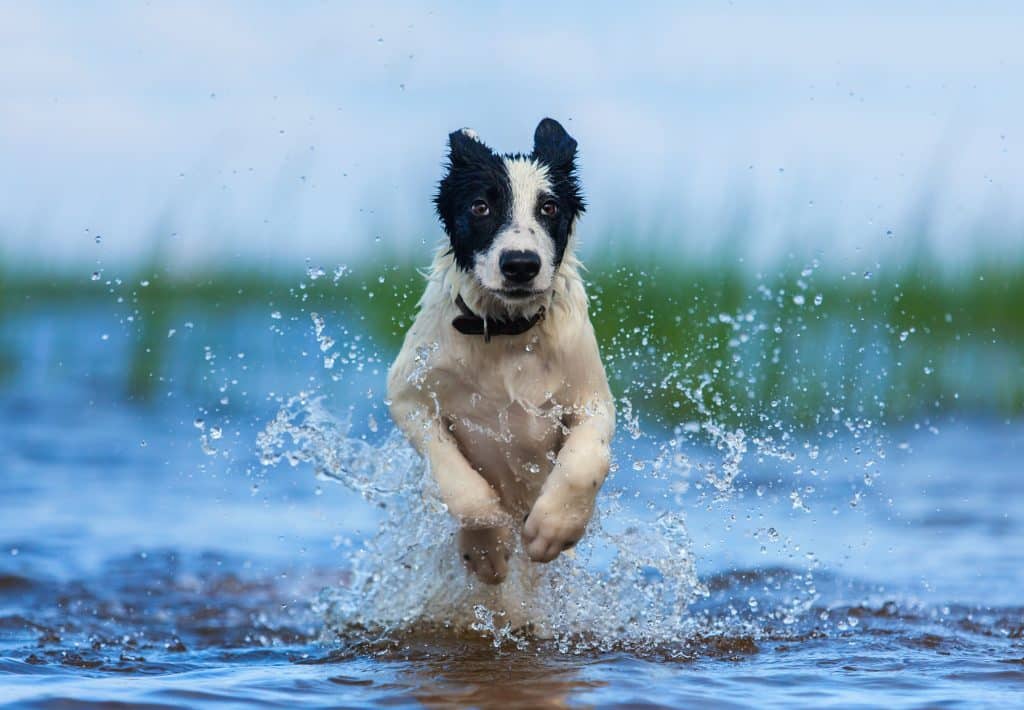Some days my Pit Bull (Greta!) is so energetic she constantly bugs me to play with her. I work from home so it’s pretty easy for her to bring me toys in an attempt to entice play time. I just sit there and think, “How much exercise does a dog need? I need to find the time to take you running every day.”
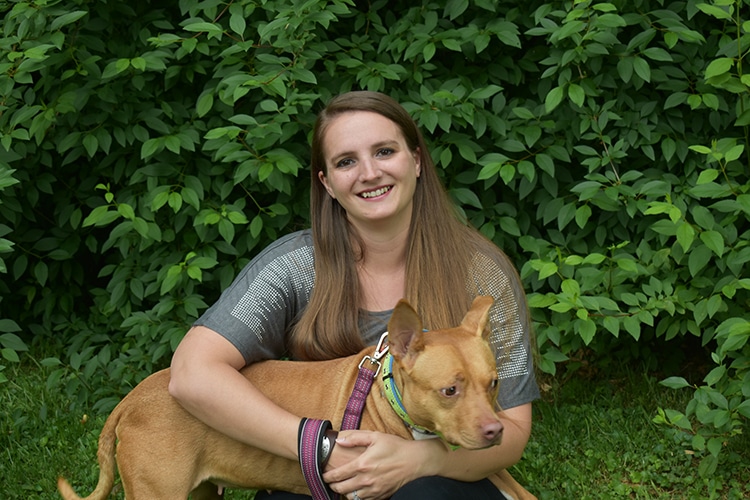
Table of Contents
Why Does Exercising Your Dog Make Sense?
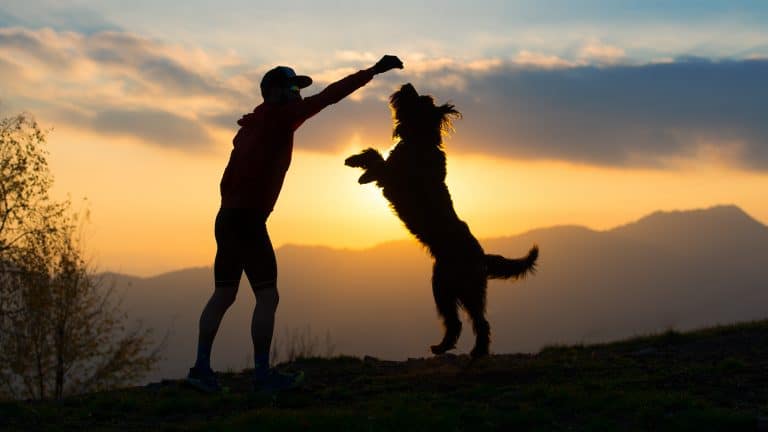
Just like humans, dogs have energy and calories to burn. They need exercise just as much as we do.
I know what you’re thinking… “But I don’t want to exercise! I don’t have time… I don’t have the energy… I’m tired all the time…
How am I supposed to exercise the dog for 30 minutes every day when I can’t exercise myself for 30 minutes every day?!”
But think about this: Do you ever wish you could spend more time with your dog? Do you wish you had more bonding time together? Do you want to be better friends with your dog?
Here’s your chance!
Here’s another thing to think about: exercising your dog doesn’t necessarily mean running 3 miles or doing exhausting aerobics. Dogs need mental exercise, too. What does that mean? It means that some days you can give your dog a puzzle toy full of kibble, treats, or other tasty morsels, and it counts as exercise! Because if it’s raining, neither one of you is (probably) not going to want to go outside.
Some breeds do have special needs that need to be taken into consideration. Other dogs slow down as they get older. Despite this, all dogs need some form of exercise every day.
Otherwise, they grow anxious, bored, unhealthy, and they’ll develop bad behaviors like chewing on your carpet or your shoes. Don’t worry, these bad behaviors should disappear as soon as your dog is active every day!
Is It Okay For My Dog To Exercise Themselves In The Garden?
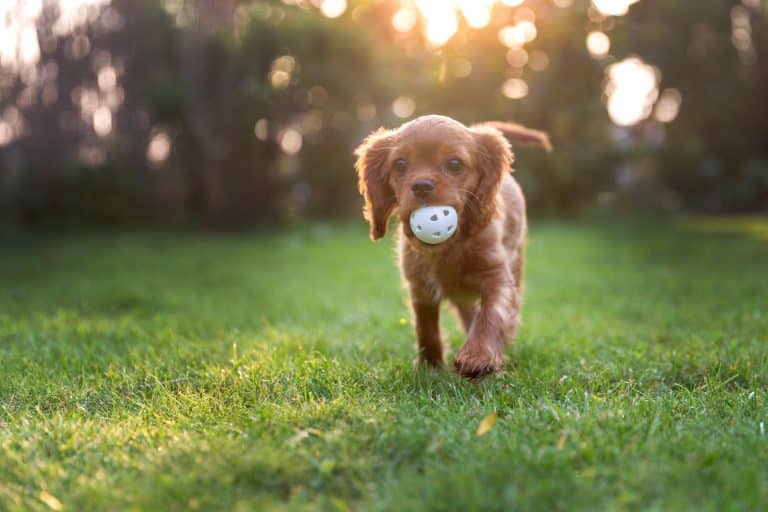
Yes, but under certain circumstances. If you have multiple dogs, letting them play in the garden can be a great way to exercise them both without requiring your active participation. Or if you have only 1 dog, it can still be a good form of exercise, but you have to watch your pup.
Let’s say you let your dog out to play in the garden and he immediately begins running and jumping and playing with toys. That’s exactly what you want! But as soon as you return to the house to do chores, he lays down to take a nap without your knowledge. You think he’s getting his 30 minutes of running but he’s just getting extra sleep.
Garden playtime works perfectly, as long as you keep watch and ensure your dog is actually exercising.
Personally, I would say not to count it as regular daily exercise. Count it as extra exercise.
Know Your Dog
If you just got your fur-baby, whether from a breeder or as an adoption, you obviously have some learning to do about his personality, daily routine, and favorite activities. One way to get to know your dog in this situation is to try different toys and activities. Give him a variety of options and see what he enjoys.
Avoid, however, asking him to run long distances or do other strenuous activities until he’s more settled into his new home and you’ve both gotten to know each other. You might not know if he has joint issues or (if he’s less than 6 months old) growth issues that could flare up.
On the other hand, if you’ve had your dog for 1 year, 2 years, or more, you know his personality pretty well and you know what kinds of activities he enjoys most. Stimulate his mind and body with lots of his favorites! If he loves balls and fetch, take your buddy to the back yard and let him chase the ball! If he loves playing tug, get a hefty rope toy and (gently) let him wrestle with it.
Please keep in mind that a blog post is not a replacement for professional veterinary advice. Consult your veterinarian before starting an exercise regimen. You and your vet know your dog best, so work together to determine the most effective method of exercise.
What Counts As Exercise?
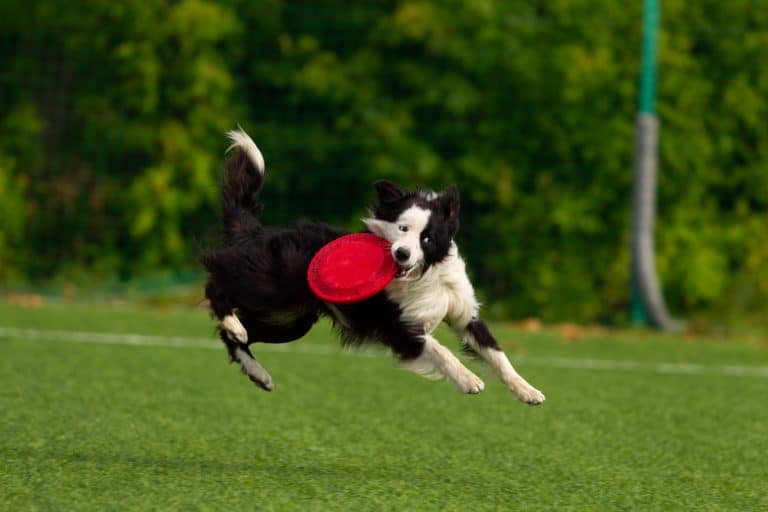
Like I wrote earlier, spending time in the back yard doesn’t really count as exercise unless you’re out there with your dog and encouraging active play time. If you leave him alone, he’ll probably just sniff around and lay down.
As humans, we understand what exercise is and how important it is to do. Dogs don’t comprehend that. If they’re in the back yard, they’re not going to start running laps because they just laid on the couch morning.
Therefore, what counts as exercise is any kind of active movement, whether it be walking or running.
- 30 minutes of walking through the neighborhood? Yes!
- 45 minutes of jogging? Yes!
- 1 hour of hiking? Definitely!
- 30 minutes of fetch in a field? You got it!
- 20 minutes of tug with a rope? Yep!
- 1 hour of agility classes? Nailed it.
- 20 minutes of swimming? Yes!
- 1 hour of tracking classes? Totally!
If your dog is tired after any of these activities, you’ve done it right. Just be careful not to exercise your dog too much.
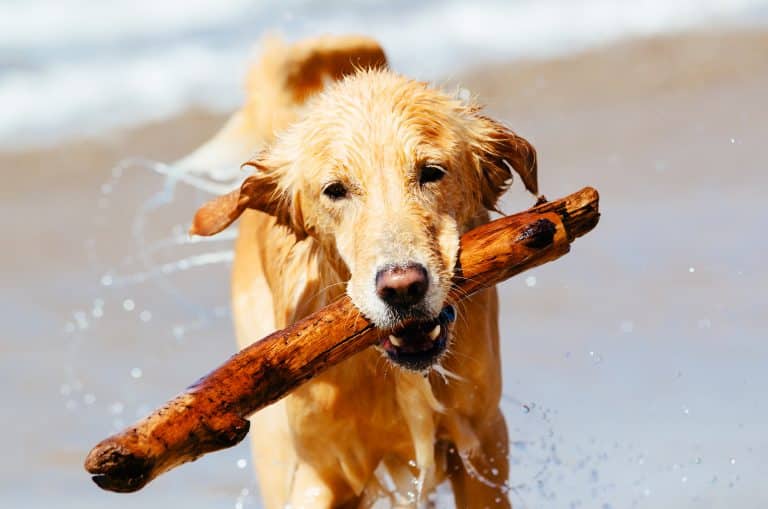
“Too much? How do I know if it’s too much?”
Keep an eye out for signs of exhaustion. If he’s panting heavily or having trouble breathing. If he lays down and no longer wants to chase the ball or run. Dogs don’t comprehend what “too much” exercise is. They’ll keep chasing the ball because their instincts tell them to. So, you have to be the voice of reason and let them quit before it’s too much.
What Doesn’t Count As Exercise?
- Unsupervised time in the back yard.
- Chewing on a bone, treat-filled toy, or another type of toy. (It’s mental stimulation, but not exercise.
How Good Is It For Me And My Dog?

First of all, it’s bonding time which means exercise is great for your relationship! And in terms of health benefits, exercise is always good for both parties! Just remember to stay within your limits of physical activity.
An activity as simple as walking can be the best form of exercise for you and your dog. It’s easy, low impact, and the entire family can participate. Young dogs and older dogs can both enjoy a daily walk. And I’m not talking multiple miles of walking, either. 30 minutes of walking will be enough!
If you want to walk more than 30 minutes, go for it! As long as you can your dog can handle it. If he’s too old and arthritic or if he’s too young, make the walk a bit shorter.
Walking improves cardiovascular health, strengthens bones and muscles, and reduces blood pressure. For humans and dogs! So, if that’s the only activity you enjoy with your dog, that’s fine! It’s a great start. About one-third of dogs are overweight due to their owner’s sedentary lifestyle. Nobody wants to be part of that statistic!
Exercising your dog has social benefits, too. If you enroll in an obedience class or agility class, your dog will make new friends and learn how to behave around other dogs. And you might make some new friends, too. Walking with a friend builds the bond between people as well as dogs.
Want to make exercise even more interesting? Wear a pedometer or track your steps through your smart phone or watch. That way, you’ll be able to see exactly how much exercise you accomplish. And you’ll be able to set goals for yourself and your pup and try to beat them!
What If My Dog Has Health Issues?
Speak with your veterinarian! You may need to stick with short walks instead of high-intensity running or jumping, such as if your dog is aging. If your dog is arthritic, your vet may suggest swimming as an exercise regimen. Water reduces pressure on joints and bones, which will make him more comfortable.
Remember, a blog post is not a replacement for veterinary advice. I love that you’re interested in exercising your dog, but in the special case that he has health issues, it’s best to visit the vet.
What Happens If Your Dog Doesn’t Get Enough Exercise?
Basically, your dog will become overweight and unhealthy. As he ages, he may develop arthritis or hip dysplasia. Some breeds are known for developing hip dysplasia, so if you have a German Shepherd, Golden Retriever, Pit Bull, or other breed, keep his weight down and take him on short walks every day.
It’s estimated that 8.3 million dogs are clinically obese and overweight dogs live approximately 1.8 years less than dogs of a healthy weight. With staggering statistics like that, it certainly scares me into taking my dog for an extra walk!
Besides becoming overweight, dogs brains can become weak without exercise and stimulation. Just like any other muscle in the body: if you don’t use it, you’ll lose it. Exercise keeps a dog’s brain sharp and functional. Chasing a ball triggers their wolf-like instincts of chasing their pretty. Playing tug does the same thing but makes them feel like they’re fighting over their prey. Even a simple walk gives them smells to smell and areas to patrol. Their brains are alert and focused during all forms of exercise.
Now let’s talk about bad behaviors that form due to boredom. If your dog doesn’t get enough exercise, he will get bored and anxious. What happens next? He will start looking for activities to fight his boredom. And those activities may not be desirable to you. I’m talking about chewing on the carpet or your shoes. He might start barking and pacing around the house to get attention.
No matter what, lack of exercise will make a dog unhealthy and unhappy. And then you’ll probably be unhealthy and most likely unhappy because it’s sad when your dog is misbehaving or sick.
Signs Your Dog Is Not Getting Enough Exercise
- Weight gain
- Arthritis
- Lack of energy (lethargy)
- Too much energy (anxious, constantly excitable)
- Chewing of inappropriate objects (furniture, carpet, shoes, etc.)
- Constant barking at “invisible” objects
- Lack of alertness
How Do Americans Exercise Their Dogs?
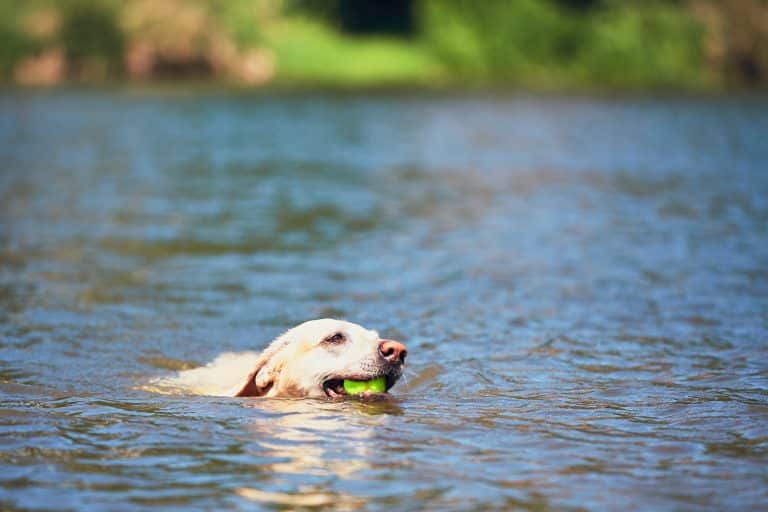
According to the AKC, Americans enjoy a variety of exercise regimens with their dogs. Most dog owners use outside play in the back yard or a daily walk as their main exercise. Other dog owners use indoor play time, dog parks, and agility competitions, such as obstacle courses, swimming, or jumping.
The Right Amount Of Exercise For Your Dog: The Age Factor
Determining how much exercise your dog needs is highly based on age and breed. Younger dogs, older dogs, and smaller dogs need less exercise than large breed adult dogs. Let’s go through each category!
How Much Daily Exercise Does A Puppy Need?
Check out this handy chart for a breakdown! But basically, a puppy that is 1 month in age needs about 5 minutes of exercise each day. At 9 months, a small breed dog can begin adult activity while a large breed dog needs 45 minutes of exercise. Then, at 14 months, a large breed dog can begin his adult activities.
How Much Daily Exercise Does An Adult Dog Need?
A good rule of thumb to follow is this: if your dog is good and tired after exercising, he’s had enough exercise. If he’s happy to lay down, take a nap, or chew on a toy, he’s had enough exercise.
You will have to experiment with different exercises and time periods to see what tires him out without over-exhausting him.
How Much Daily Exercise Does A Senior Dog Need?
As a dog gets older, he will need less exercise. Arthritis, hip dysplasia, or (quite simply) reduced energy means the time spent exercising and the activity itself should change. Older dogs may be happiest with a short, gentle walk on a daily basis. Other dogs may enjoy swimming since the activity reduces pressure on old joints.
Don’t push your dog to perform the activities he once was excited to do. If he shows signs of exhaustion fatigue, let him stop and rest.
How Much Exercise Does A Specific Dog Breed Need?
Check out this awesome chart with a breakdown of each breed’s category and how much physical and mental exercise they need! Let me give you a summary.
Herding dogs such as Cattle Dogs, Shepherds, Sheepdogs, Collies, and Corgis have high mental and physical activity needs. They often enjoy herding trials, agility competitions, obedience training, trick frisbee, flyball, and dog dancing. They’ll need 120 to 180 minutes of active, engaged, exercise.
Sporting dogs such as Pointers, Spaniels, Retrievers, Weimaraner, and Vizslas have moderate mental and high physical activity needs. They often enjoy fetch, frisbee, biking, jogging, flyball, agility, and hunting. They’ll need 120 to 180 minutes of active running.
Hound dogs such as Greyhounds, Afghans, Coonhounds, Foxhounds, Dachshunds, Rhodesian Ridgebacks, and Wolfhounds have high physical exercise needs. They like biking, jogging, hunting, off-leash running, and lure coursing. They need at least 60 minutes of solid running for large breeds plus another 60 minutes of romping. Small breeds need at least 60 minutes of off-leash romping.
Rat and Small Game Terriers such as Airedales, Hairless, Border, Schnauzer, Fox, Rat, Scottish, and Manchester Terries have high physical exercise needs. They enjoy jogging, lure coursing, and off-leash running. They need at least 60 minutes of outdoor exercise plus 30 to 60 minutes of engaged play time.
Large Terrier and Working Dogs such as Staffordshire, Bull Terriers, Boxers, Dobermans, and Great Danes have moderate physical and moderate mental exercise needs. They enjoy pulling, jogging, biking, swimming, protection, obedience, and hiking. They need at least 60 minutes of mental and physical activity each day.
Lastly, Non-Sporting and Toy dogs such as Eskimo dogs, Bichon, Shar-Pei, Bulldogs, and Poodles have moderate physical and moderate mental exercise needs. Smaller dogs enjoy indoor obedience like dancing and daily walks for 30 to 60 minutes each day. Larger dogs enjoy jogging, fetch, and agility for 60 to 120 minutes each day.
What If I Have A Mixed Breed Dog?
If your mutt is so mixed that you don’t know what breed(s) you have, experiment with different activities and see what he enjoys!
In terms of how much time spent exercising each day, follow the rule of thumb I mentioned earlier about exercising your dog until he’s tired. Try longer sessions and see if it’s too much for him. Try shorter sessions and see if he’s still energetic.
Here Are A Few Tips On How You And Your Dog Can Exercise Together
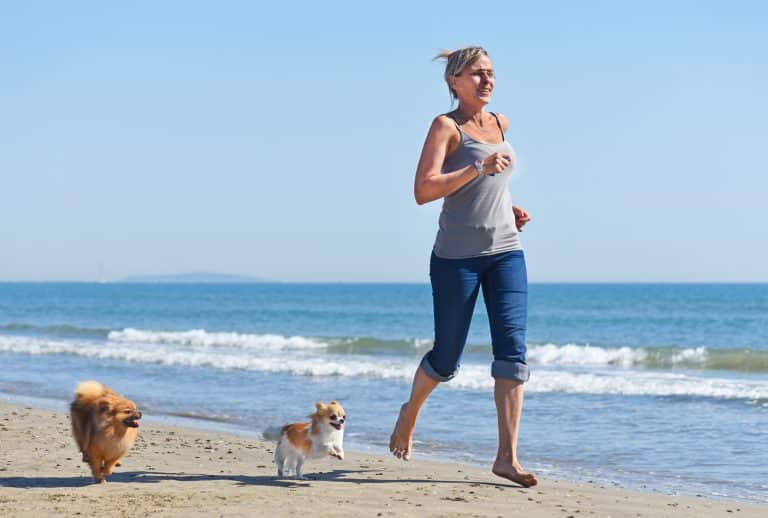
I would love to give you a few tips on exercising with your dog! But please remember that this is not a replacement for veterinary advice. So, consult a professional! But thanks for reading!
- Wear a pedometer so you know how far you’ve walked/jogged. Set goals for yourself and your fur-baby and set out to beat them!
- Start slow if you and/or your dog is new to exercise. If either one of you shows signs of exhaustion, stop and take a break. Don’t overdo it!
- Establish an exercise routine that you’re comfortable with. Dogs love routine! And it’ll get you into the habit more.
- Avoid exercising in unsuitable conditions. If the pavement is too hot for your hand, it’s too hot for your dog. If it’s blistering cold outside, it’s too cold for outdoor exercise.
- Give your dog new toys to keep your activities interesting!
- Introduce your dog to new places to keep his brain alert and interested!
- Don’t be afraid to hire a professional dog walker if you’re too busy to take daily walks. Your fur-baby needs it!
Fun Ways To Exercise Together Outdoors
- Walking
- Jogging
- Hiking
- Swimming
- Fetch
- Agility
- Tracking
- Cart-pulling
Fun Ways To Exercise Together Indoors:
- Tug
- Obedience training
- Tracking
Symptoms Of Over-Exercise Can Include
While it’s important to provide adequate exercise for your dog, it is also important to recognize the signs of over-exercise. Too much activity can result in injury, heat stroke, or worse.
- Excessive panting during or after exertion
- Extreme thirst
- Lagging behind when they are normally in front of you
- Confusion and lack of focus
- Overtired or excessive sleeping or laying down
- Signs of overheating or heat stroke (dogs can’t cool down as fast as humans, so the weather doesn’t have to be super hot for them to overheat)
Are There Types Of Exercising You Should Avoid?
Overall, exercise is a wonderful and essential activity in life, for both dogs and humans. For dogs, however, there are some activities they should avoid depending on certain health conditions.
For example, older dogs with joint problems, arthritis, or hip dysplasia should avoid high-impact activities like running on asphalt. Low-impact activities, such as swimming, would be a better option.
Dogs who love tug of war need to be monitored closely. They may get to serious about it and injure their neck or teeth while whipping the rope back and forth. Ask them to drop the toy once in a while to ensure you still have control of the game.
All outdoor activities should be monitored and shortened if the weather is very hot. Dogs overheat quicker than humans and do not understand when to stop and rest. Heat stroke is a serious concern and should be avoided.
Whatever activity you choose for exercise, make sure your dog has adequate water. Make sure it’s fresh and cold. Maybe throw in a few ice cubes to cool your pup even quicker.
How To Fit In Dog Exercise If You Work Full-Time ?
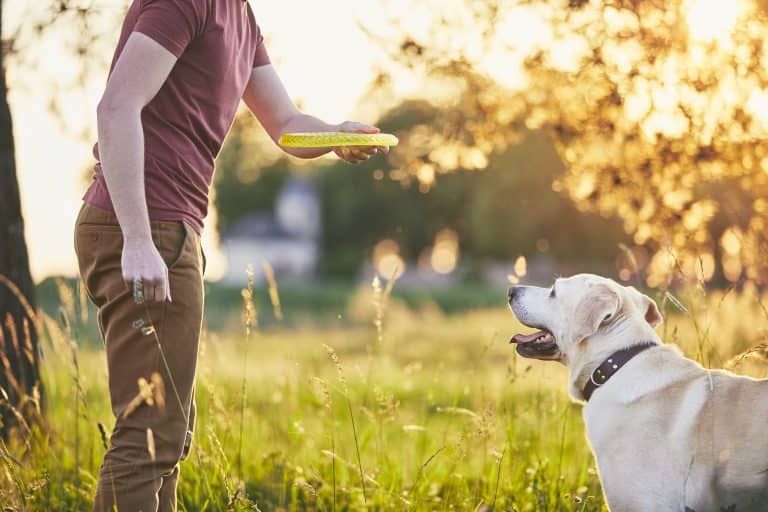
Many of us work full-time away from home but still want the joy of coming home to a furry best friend. I get that. I’m in the same boat as you! So how do you fit all that exercise time into your daily routine?
Start with a short, 30-minute walk before or after work. Before work is better, if possible, because your pup will be tired and relaxed while you’re away from home.
Play time after work is another option. Play tug, Fetch, Flyball, Frisbee… you choose! Your dog will love know that he gets to play a fun game every day when you come home.
While you’re at work, providing your dog with mentally-stimulating toys can help reduce his boredom for 8+ hours. Rubber toys stuffed with treats or puzzle toys full of hidden kibble are often a good idea. Personally, I like to fill a Kong toy with treats, then stuff some peanut butter int here, and freeze it. Not only does it keep my pup occupied while I’m busy, it gives her a yummy snack, and a way to cool off!
Besides that, doggy daycare or a dog walker might be necessary. Even simply having a friend or family member stop by your house while you’re working and taking the pups on a walk is a perfect way to exercise your dog! I’ve done it many times for my family members. The pups are always so excited to see me because they know it’s time for a walk!
Best Toys To Exercise Your Dog
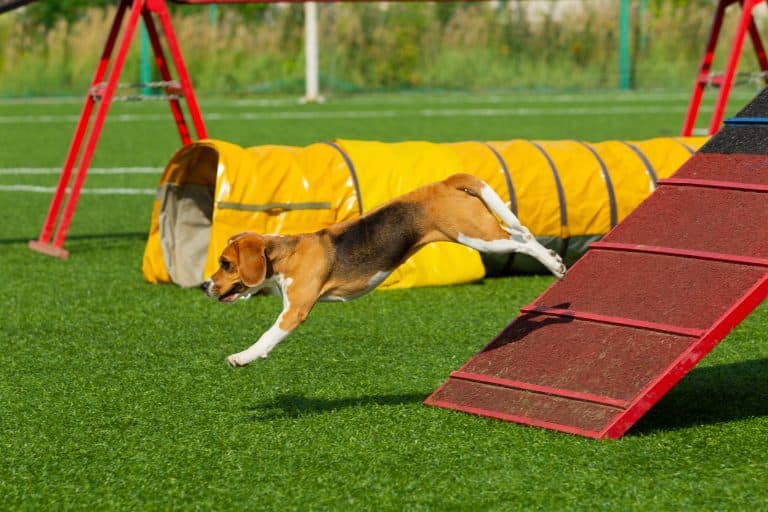
There are so many types of dog toys on the market. One quick search and you’ll probably be overwhelmed with options. I sure am! But I’ve done my research and I’ve found which toys are high-quality and will keep my puppy entertained.
To make it easier for you, I’ve listed a few solid options that I love, too.
There are so many types of dog toys on the market. One quick search and you’ll probably be overwhelmed with options. I sure am! But I’ve done my research and I’ve found which toys are high-quality and will keep my puppy entertained.
Ball launchers
Some are manual and some are automatic. Basically, they chuck the ball and your dog goes and gets it and brings it back. With the automatic ball launchers, the dog has to drop the ball back into the launcher and he’s rewarded with another launched ball! Either way, it’s a game of fetch that your fur-baby will have a blast with.
Dog bike leash
This is a special leash that attaches to a bike with a pole. The pole sits horizontally so that the leash stays away from the bike and isn’t tangled in the chains or pedals. A doggy bike leash gives you hands-free riding.
Flirt pole
This is a long pole (usually the length of a fishing pole) with a rope on attached to the end. On the other end of that rope is a small stuffed animal or feathers. Your dog’s instinct is to chase the small stuffed animal. You use the pole to make the animal “dance” so that your dog has the challenge of catching it. A flirt pole is good for both physical and mental exercise.
Dog treadmill
Similar to a human treadmill, dogs walk, jog, or run in place for exercise! Side guards and leash attachments prevent your dog from escaping his exercise regimen. I love the idea of a doggy treadmill for days when the rain won’t quit and your pup is all wound up.
Dog Agility Training Tunnel
Just like you see in agility competitions! You can teach your pup to run through the tunnel on command. Make sure to use the same command every time and reward with a treat at the other end. Pups may be fearful at first, but you can use kibble and treats to lure him through and show him that it’s not scary.
Dog Exercise Wheel
Yep, like a hamster wheel but REALLY BIG. They even make them for large breed dogs. Train your pup to run on this fun contraption and he’ll be happily entertained on all those rainy days.
Summary
I hope you learned a few tidbits about doggy exercise! It’s one of the most important parts of having a dog and keeping him happy. Daily activity is essential. I cannot stress that enough. All it takes is 30 minutes each day, though, so don’t fret.
Now it’s your turn! Share your doggy exercise tips and photos! I would love to see all of your fur-babies.
Did you find this blog post valuable? I would love to hear your response in the comments! Please share it with your closest dog lover’s community!
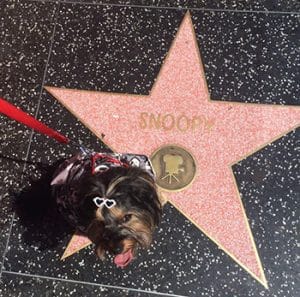
One Request From Speedy
Kelly Sidehof put so much effort writing this blog post to provide value to the dog parent community. It’ll be very helpful for me, if you consider sharing it on social media networks.
SHARING IS ♥️

